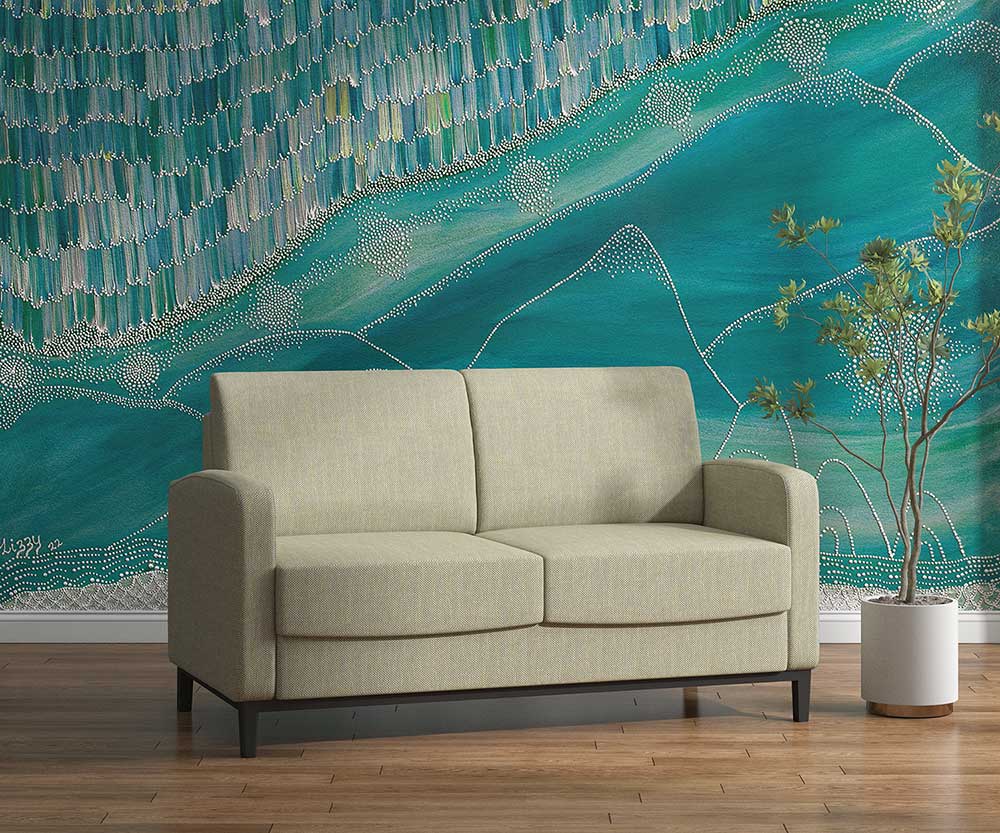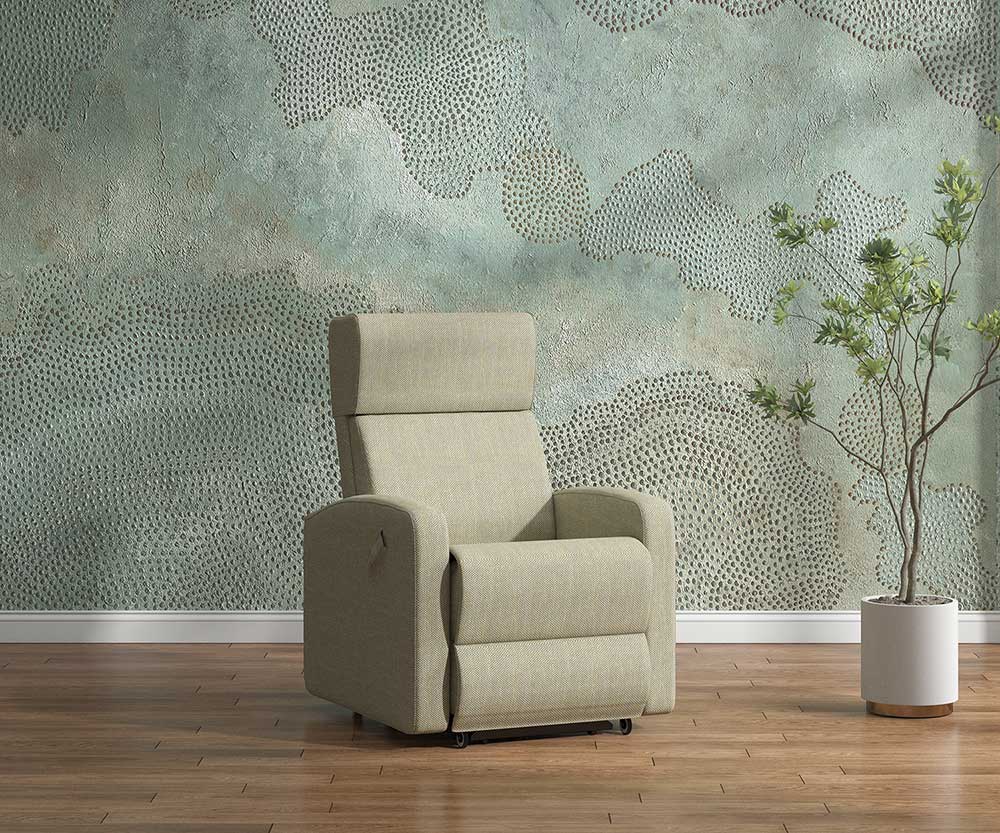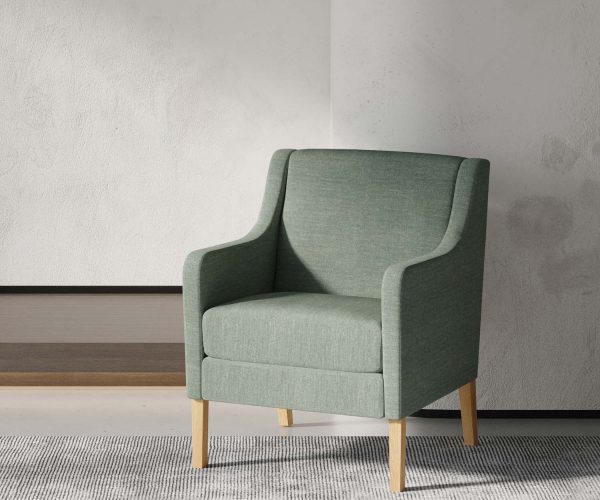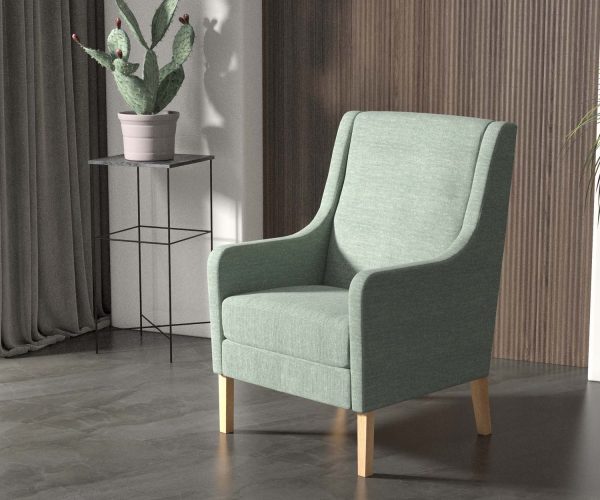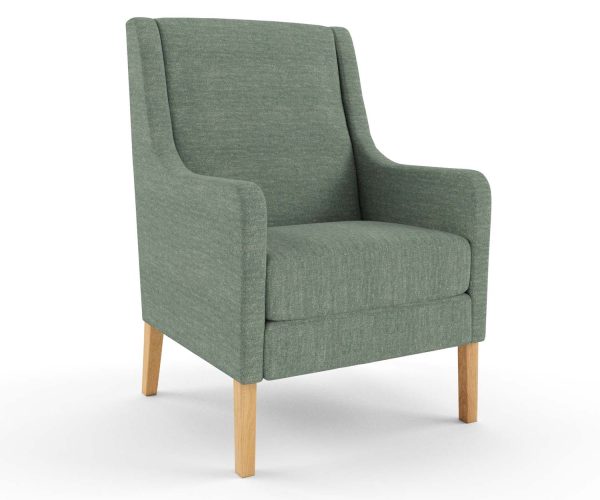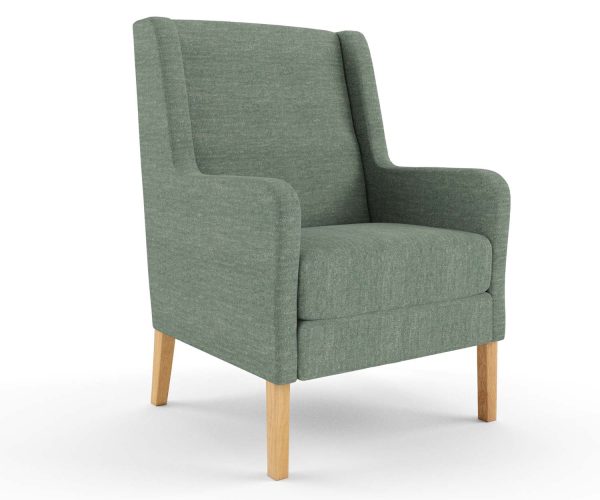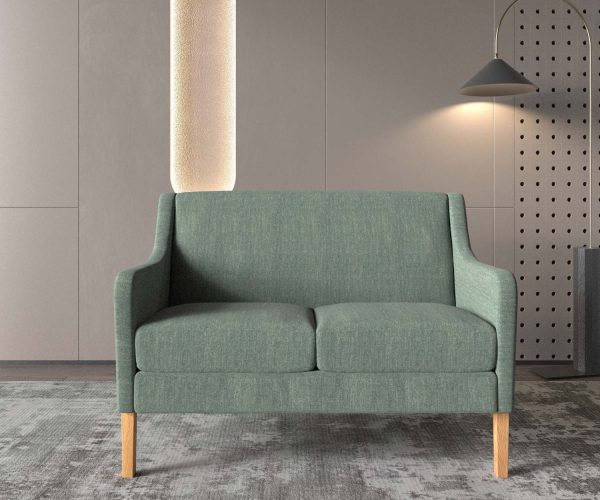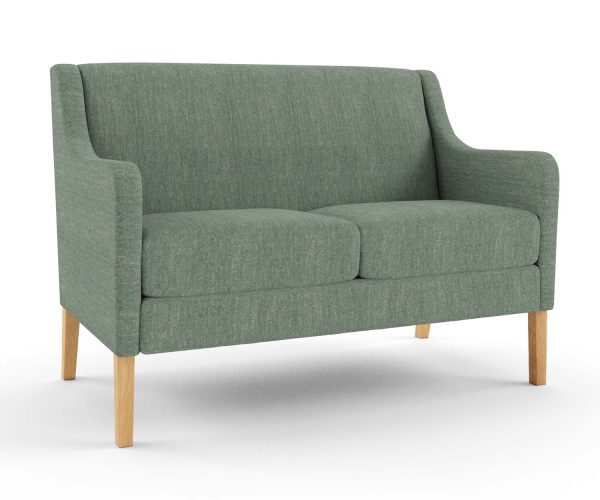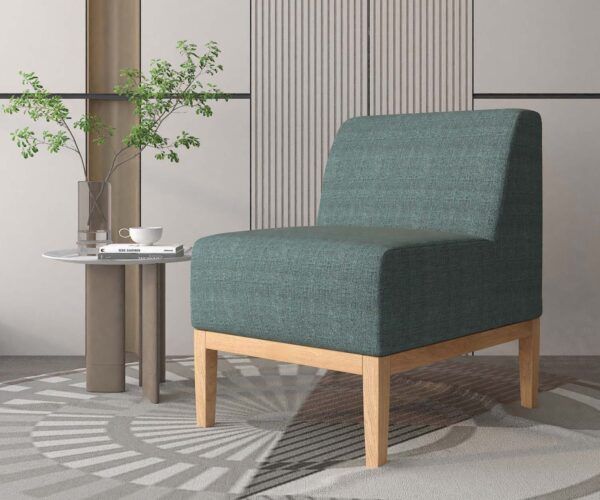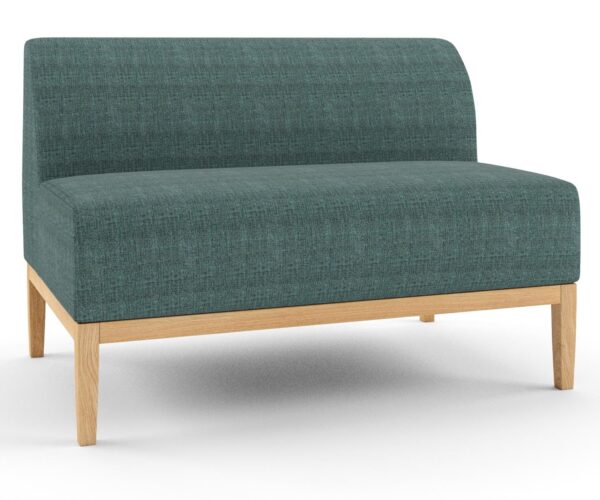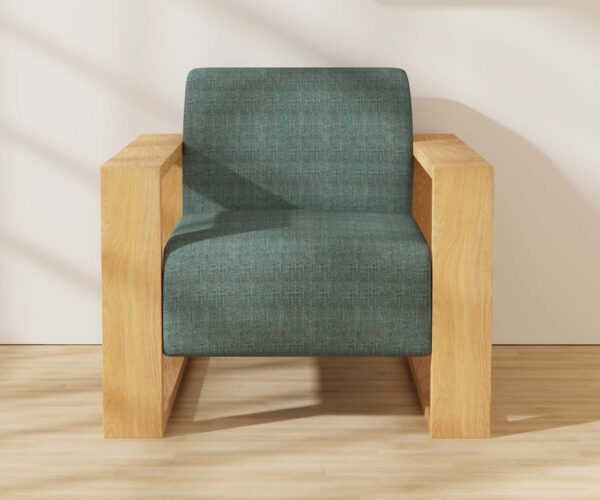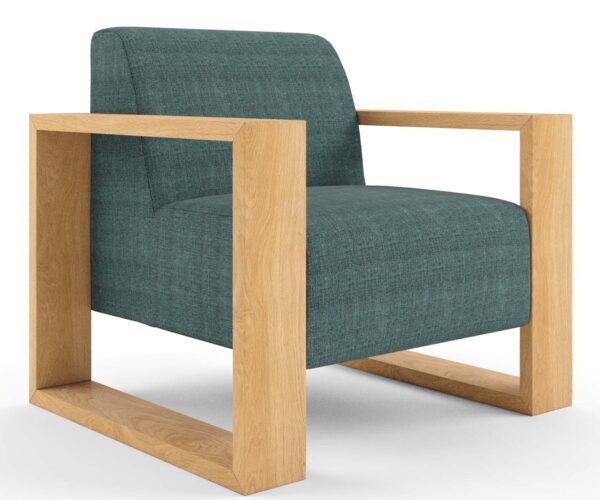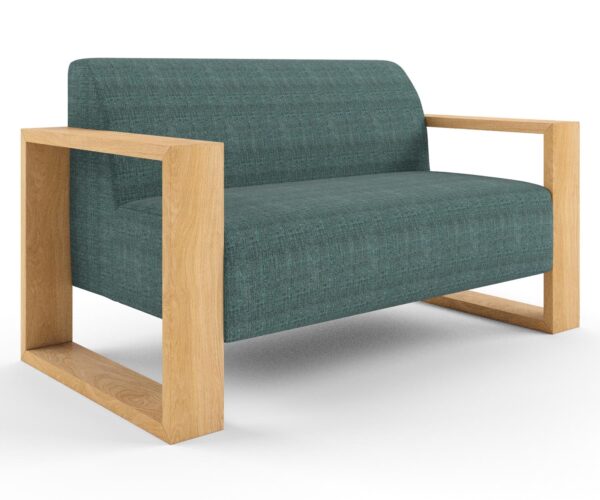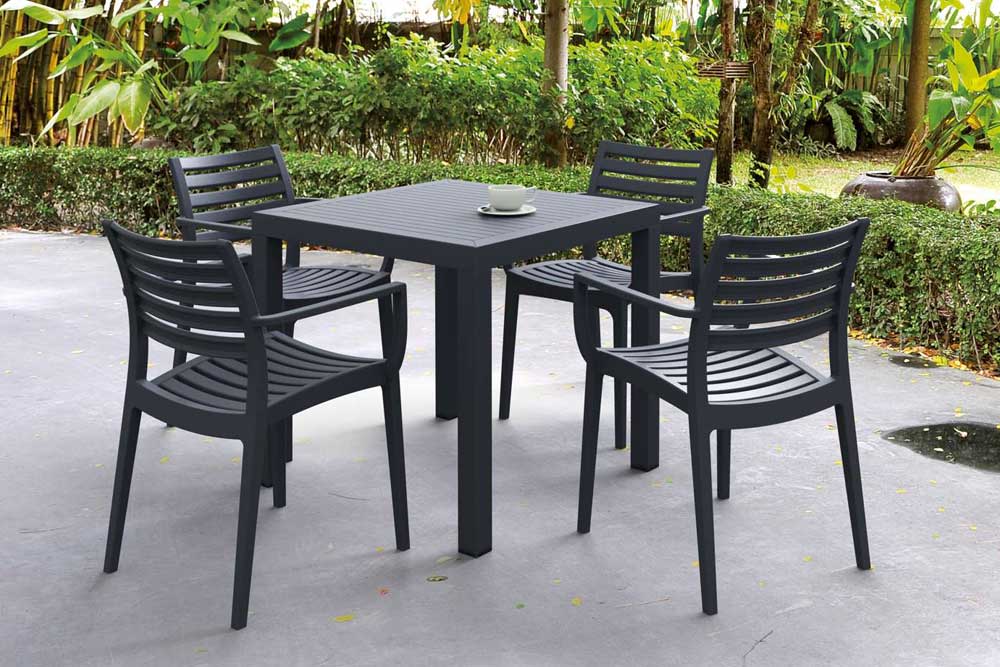Unveiling Elegance: A Glimpse into the Latest Upholstery Fabric Design Trends in Australia
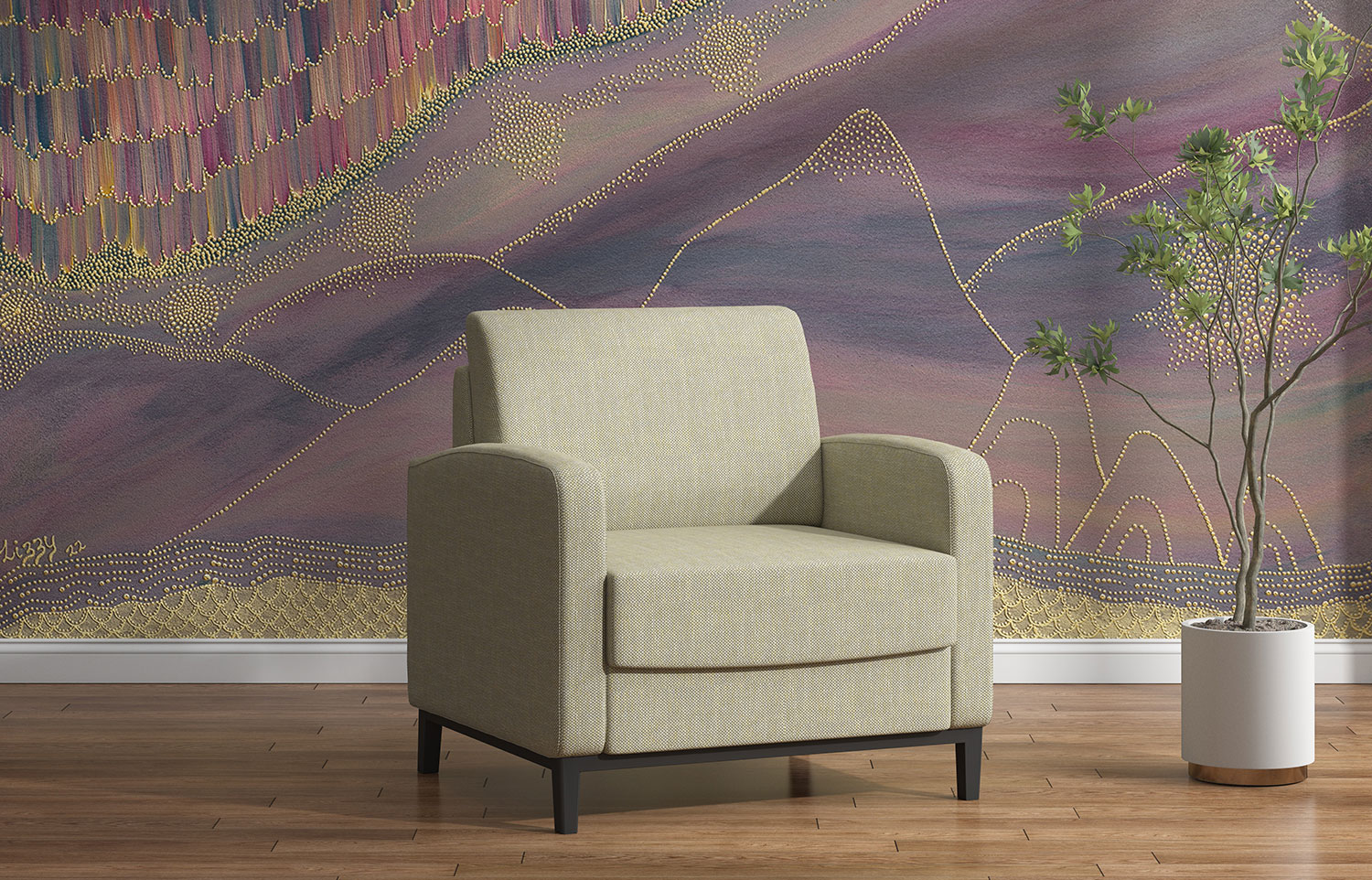
Featured image credit: Wall mural artwork: Galiyn Water Raining Banganha Original by Lizzy Stageman. FHG Slimline Armchair covered in Materialised Fling Alpine.
In recent years, there has been a significant shift in the world of design, especially in the realm of upholstery fabric design. This change is driven by an intriguing blend of sustainability, heritage aesthetics, and the rise of indigenous designers. If you’re a Manager in an Aged Care or Retirement Village in Australia, it’s time to tune in.
Celebrating Raw Materials and Sustainability
Current fabric trends are beautifully encapsulating the essence of raw materials. Natural and eco-friendly fabrics are making a big splash in the industry, offering not only a healthier choice but also a unique aesthetic appeal that exudes sophistication and comfort. This shift towards sustainable choices is more than just a trend – it’s a movement that respects our planet and its resources.
Choosing upholstery fabrics made from raw materials requires careful consideration to ensure that the fabrics are not only aesthetically pleasing but also durable and sustainable. Here are some tips to help you make informed decisions:
- Research Raw Material Options: Familiarize yourself with different raw materials commonly used in upholstery fabrics, such as cotton, linen, wool, silk, and various plant-based fibers like jute or hemp. Understand the characteristics and properties of each material, including their durability, texture, and maintenance requirements.
- Durability and Intended Use: Consider the intended use of the furniture. Furniture in high-traffic areas, such as lounges in retirement villages, will require more durable fabrics. Wool and synthetic blends are often more resilient options, while delicate fabrics like silk might be better suited for less-used spaces.
- Natural vs. Blended Fabrics: While fabrics made entirely from a single raw material can be desirable for their natural appeal, blends of natural and synthetic fibers can enhance durability and ease of maintenance. Consider a blend that combines the benefits of both materials.
- Sustainability and Eco-Friendliness: Look for upholstery fabrics that are certified as environmentally friendly, such as those made from organic or sustainably sourced materials.
- Color and Design: The raw material used can influence the appearance of the fabric. Natural fibers like cotton and linen tend to have a more matte finish, while silk has a luxurious sheen. Consider how the material’s inherent qualities will affect the overall look of the furniture.
- Texture and Feel: The texture of the fabric contributes to both aesthetics and comfort. Raw materials like linen can provide a relaxed and textured appearance, while wool offers warmth and coziness. Opt for materials that align with the tactile experience you want to create.
- Maintenance and Cleaning: Different raw materials have varying care requirements. Consider the ease of cleaning and maintenance, especially in environments where furniture might be exposed to spills or stains. Some natural fibers can be more prone to staining and fading than synthetic options.
- Allergies and Sensitivities: Keep in mind any potential allergies or sensitivities that residents might have to certain materials. Wool, for instance, might trigger allergies in some individuals.
- Test Samples: Request fabric samples before making a final decision. This allows you to assess the texture, color, and overall feel of the fabric in person. It’s also an opportunity to see how the fabric performs when subjected to wear and tear.
- Consider Local Resources: Depending on your location, consider sourcing upholstery fabrics made from raw materials that are locally available. This can reduce the environmental impact associated with transportation and support local artisans.
- Consult with Professionals: If you’re unsure about the best upholstery fabric for your specific needs, consult with interior designers, furniture manufacturers, or upholstery experts. They can provide valuable insights based on their experience.
By carefully considering the raw materials used in upholstery fabrics, you can select options that align with your design vision, durability requirements, and sustainability goals, ensuring that the chosen fabrics contribute to a comfortable and visually appealing environment.
The Heritage Look Revival
Heritage aesthetics are making a grand comeback. Traditional designs, patterns, and colours are being embraced, adding a touch of nostalgia and warmth to any space. Warwick Fabrics, for instance, has introduced a range of heritage-inspired designs that beautifully blend the old with the new.
“Heritage aesthetics” refers to design elements, styles, and motifs that are influenced by a specific cultural or historical period, often reflecting the traditions, customs, and visual characteristics of that time. Heritage aesthetics draw inspiration from the past and incorporate elements that evoke a sense of nostalgia, history, and cultural identity.
In the context of design, heritage aesthetics might involve incorporating design elements, patterns, colors, and materials that were prevalent in a particular era or cultural context. This can include reinterpreting traditional designs in a contemporary way, combining classic styles with modern sensibilities, and creating a sense of familiarity and connection to the past while still remaining relevant in the present.
For example, in the realm of upholstery fabric design, heritage aesthetics could involve using patterns inspired by historical textiles, integrating traditional motifs, or recreating color palettes that were popular in a specific time period. This approach allows designers to pay homage to the past while infusing their creations with a fresh perspective and relevance for modern spaces.
Heritage aesthetics in design often evoke a sense of timelessness, cultural richness, and a unique blend of old and new. It’s a way to bridge the gap between history and contemporary living, creating designs that resonate with both tradition and the present moment.
The Rise of Indigenous Designers
Indigenous designers are leaving a significant imprint on the Australian upholstery fabric industry. Their unique perspectives, inspired by their rich culture and history, offer fresh and exciting designs. This rise of indigenous designers has ushered in a wave of unique patterns, textures, and colours that truly encapsulate the Australian landscape and heritage. Fabric houses such as Materialised have recently collaborated with Indigenous artists including Jimmy Pike, Lizzy Stageman and Robyn Caughlan.
FAQs About Upholstery Fabric Design in Australia
What are the current trends in upholstery fabric design in Australia?
Current trends include the use of natural and sustainable materials, bold patterns, rich textures, and a mix of classic and contemporary styles.
How does sustainability play a role in upholstery fabric design trends in Australia?
Sustainable fabrics, such as organic cotton, linen, and recycled materials, are gaining popularity as consumers seek environmentally friendly options for upholstery.
Are there specific color palettes that are trending in Australian upholstery fabric design?
Neutral tones, earthy hues, and muted pastels are currently popular in Australian upholstery fabric design, creating a sense of calm and versatility.
What role do textures and patterns play in current upholstery fabric trends?
Rich textures, such as bouclé and velvet, are in demand, along with bold patterns like florals, geometric shapes, and abstract designs that add visual interest to furniture.
Are there influences from Australian culture or nature in upholstery fabric design trends?
Australian flora and fauna often inspire upholstery fabric designs, with patterns reflecting native plants, animals, and landscapes, connecting design to the local environment.
How can upholstery fabric design trends accommodate both classic and contemporary styles?
Current trends embrace a fusion of classic and contemporary elements, allowing for versatility in design that suits both traditional and modern aesthetics.
What materials are commonly used in upholstery fabric design in Australia?
Besides traditional materials like cotton and polyester, there’s a growing use of sustainable materials, natural fibers, and performance fabrics that offer durability and easy maintenance.
How do Australian upholstery fabric designers address the need for both aesthetics and functionality?
Designers prioritize functionality by incorporating performance fabrics that resist stains and wear while ensuring aesthetic appeal through thoughtful design elements.
Are there trends in the use of contrasting textures or materials in upholstery fabric design?
Yes, contrasting textures, such as combining smooth leather with textured fabric or mixing different fabric types, are popular trends that add depth and visual interest.
How can consumers stay updated on the latest upholstery fabric design trends in Australia?
Consumers can stay informed through design magazines, furniture exhibitions, and online platforms showcasing the latest collections from Australian fabric designers and manufacturers.
Texture Takes Center Stage
The tactile experience of upholstery fabrics is as crucial as their visual appeal. Textured fabrics are stealing the limelight, with luxurious velvets, nubby linens, and intricate weaves adding depth and dimension to furniture pieces. These textures invite touch and create a multi-sensory experience that resonates with residents seeking comfort and sophistication.
While functionality is crucial, aged care facilities also prioritize resident comfort. Textured fabrics that provide a soft and inviting feel are in demand, creating a sense of coziness and well-being for residents.
Biophilic Design
Biophilic design is an innovative approach to interior and architectural design that seeks to reconnect human beings with nature and natural elements. It’s based on the idea that incorporating elements of the natural world into our built environments can have positive effects on our well-being, health, and overall quality of life. Biophilic design aims to create spaces that foster a strong connection to nature, even within urban and indoor settings.
Key principles and elements of biophilic design include:
- Natural Light: Maximizing natural light through large windows, skylights, and light wells. Sunlight not only illuminates spaces but also affects our circadian rhythms and mood.
- Indoor Plants: Incorporating live plants and greenery into interior spaces. Plants improve air quality, provide visual appeal, and create a sense of tranquility.
- Natural Materials: Using materials such as wood, stone, and natural textiles that evoke a tactile and sensory connection to nature. These materials can contribute to a warm and inviting ambiance.
- Water Features: Incorporating water elements like indoor fountains, reflecting pools, or aquariums. The sound and sight of water can have a calming and soothing effect.
- Views of Nature: Designing spaces to provide views of natural landscapes, outdoor gardens, or courtyards. Views of nature have been shown to reduce stress and increase well-being.
- Natural Colors and Patterns: Incorporating earthy tones, shades of green, and other colors found in natural environments. Natural patterns, such as those inspired by leaves or flowing water, can also create a sense of harmony.
- Biomorphic Shapes: Including design elements inspired by natural forms, such as curves, spirals, and organic shapes. These shapes can create a sense of comfort and familiarity.
- Natural Ventilation: Designing spaces that allow for cross-ventilation and fresh air circulation. This can improve indoor air quality and create a more pleasant environment.
- Wildlife and Habitat: Incorporating features that attract local wildlife, such as bird feeders or butterfly gardens. Observing wildlife can provide a sense of connection to the natural world.
- Multi-Sensory Experiences: Engaging multiple senses by incorporating elements like natural scents, textures, and sounds. For example, the sound of flowing water or the scent of fresh flowers can enhance the biophilic experience.
Biophilic design is particularly relevant in healthcare and senior living environments like aged care facilities and retirement villages. Research suggests that exposure to natural elements and biophilic design principles can contribute to reduced stress levels, improved cognitive function, faster recovery times, and increased overall well-being for residents.
In the context of aged care, biophilic design can create spaces that feel nurturing, calming, and inviting for residents. By bringing nature indoors and integrating biophilic elements, these facilities can provide a more holistic and supportive environment that promotes both physical and emotional wellness.
Durability and Functionality: A Must-Have
In an aged care facility or retirement village, functionality and durability are as important as design and aesthetic appeal. The upholstery fabric should withstand daily wear and tear while remaining comfortable and visually pleasing.
Tips for Choosing Fabrics in Aged Care Environments
When you’re choosing fabrics for an aged care environment, keep the following points in mind:
- Performance Fabrics: Aged care facilities are increasingly opting for performance fabrics that offer durability, stain resistance, and ease of cleaning. These fabrics are designed to withstand heavy use and frequent cleaning without compromising on comfort and aesthetics.
- Waterproof: Choosing waterproof fabrics for aged care environments is essential to ensure the longevity and cleanliness of furniture while maintaining the comfort and well-being of residents. One notable option in the realm of waterproof fabrics is Crypton, a performance fabric known for its durability, stain resistance, and ease of maintenance.
- Odor Resistance: Fabrics like Crypton have an antimicrobial treatment that helps inhibit the growth of bacteria and odors, promoting a cleaner and fresher atmosphere.
- Comfort: Opt for soft, comfortable fabrics that make the residents feel at home.
- Durability: Choose high-quality fabrics that can withstand regular use and cleaning.
- Easy to Clean: Fabrics that resist stains and are easy to clean can save a lot of time and effort.
- Aesthetically Pleasing: Beautiful designs and colours can enhance the mood and overall environment of the facility.
Final Thoughts
The latest upholstery fabric design trends in Australia offer a perfect blend of style, comfort, and durability. As aged care and retirement village managers, incorporating these trends into your facilities can help create a more welcoming, comfortable, and stylish environment for residents. Embrace these trends and transform your facility into a haven of elegance and comfort.
Popular Choices for Aged Care Facility Seating
Creating a comfortable and supportive environment in aged care facilities hinges on furniture decisions that prioritize comfort, safety, personalization, and social interaction, ultimately enhancing the residents’ well-being and quality of life.
More News
Unveiling Elegance: A Glimpse into the Latest Upholstery Fabric Design Trends in Australia

Featured image credit: Wall mural artwork: Galiyn Water Raining Banganha Original by Lizzy Stageman. FHG Slimline Armchair covered in Materialised Fling Alpine.
In recent years, there has been a significant shift in the world of design, especially in the realm of upholstery fabric design. This change is driven by an intriguing blend of sustainability, heritage aesthetics, and the rise of indigenous designers. If you’re a Manager in an Aged Care or Retirement Village in Australia, it’s time to tune in.
Celebrating Raw Materials and Sustainability
Current fabric trends are beautifully encapsulating the essence of raw materials. Natural and eco-friendly fabrics are making a big splash in the industry, offering not only a healthier choice but also a unique aesthetic appeal that exudes sophistication and comfort. This shift towards sustainable choices is more than just a trend – it’s a movement that respects our planet and its resources.
Choosing upholstery fabrics made from raw materials requires careful consideration to ensure that the fabrics are not only aesthetically pleasing but also durable and sustainable. Here are some tips to help you make informed decisions:
- Research Raw Material Options: Familiarize yourself with different raw materials commonly used in upholstery fabrics, such as cotton, linen, wool, silk, and various plant-based fibers like jute or hemp. Understand the characteristics and properties of each material, including their durability, texture, and maintenance requirements.
- Durability and Intended Use: Consider the intended use of the furniture. Furniture in high-traffic areas, such as lounges in retirement villages, will require more durable fabrics. Wool and synthetic blends are often more resilient options, while delicate fabrics like silk might be better suited for less-used spaces.
- Natural vs. Blended Fabrics: While fabrics made entirely from a single raw material can be desirable for their natural appeal, blends of natural and synthetic fibers can enhance durability and ease of maintenance. Consider a blend that combines the benefits of both materials.
- Sustainability and Eco-Friendliness: Look for upholstery fabrics that are certified as environmentally friendly, such as those made from organic or sustainably sourced materials.
- Color and Design: The raw material used can influence the appearance of the fabric. Natural fibers like cotton and linen tend to have a more matte finish, while silk has a luxurious sheen. Consider how the material’s inherent qualities will affect the overall look of the furniture.
- Texture and Feel: The texture of the fabric contributes to both aesthetics and comfort. Raw materials like linen can provide a relaxed and textured appearance, while wool offers warmth and coziness. Opt for materials that align with the tactile experience you want to create.
- Maintenance and Cleaning: Different raw materials have varying care requirements. Consider the ease of cleaning and maintenance, especially in environments where furniture might be exposed to spills or stains. Some natural fibers can be more prone to staining and fading than synthetic options.
- Allergies and Sensitivities: Keep in mind any potential allergies or sensitivities that residents might have to certain materials. Wool, for instance, might trigger allergies in some individuals.
- Test Samples: Request fabric samples before making a final decision. This allows you to assess the texture, color, and overall feel of the fabric in person. It’s also an opportunity to see how the fabric performs when subjected to wear and tear.
- Consider Local Resources: Depending on your location, consider sourcing upholstery fabrics made from raw materials that are locally available. This can reduce the environmental impact associated with transportation and support local artisans.
- Consult with Professionals: If you’re unsure about the best upholstery fabric for your specific needs, consult with interior designers, furniture manufacturers, or upholstery experts. They can provide valuable insights based on their experience.
By carefully considering the raw materials used in upholstery fabrics, you can select options that align with your design vision, durability requirements, and sustainability goals, ensuring that the chosen fabrics contribute to a comfortable and visually appealing environment.
The Heritage Look Revival
Heritage aesthetics are making a grand comeback. Traditional designs, patterns, and colours are being embraced, adding a touch of nostalgia and warmth to any space. Warwick Fabrics, for instance, has introduced a range of heritage-inspired designs that beautifully blend the old with the new.
“Heritage aesthetics” refers to design elements, styles, and motifs that are influenced by a specific cultural or historical period, often reflecting the traditions, customs, and visual characteristics of that time. Heritage aesthetics draw inspiration from the past and incorporate elements that evoke a sense of nostalgia, history, and cultural identity.
In the context of design, heritage aesthetics might involve incorporating design elements, patterns, colors, and materials that were prevalent in a particular era or cultural context. This can include reinterpreting traditional designs in a contemporary way, combining classic styles with modern sensibilities, and creating a sense of familiarity and connection to the past while still remaining relevant in the present.
For example, in the realm of upholstery fabric design, heritage aesthetics could involve using patterns inspired by historical textiles, integrating traditional motifs, or recreating color palettes that were popular in a specific time period. This approach allows designers to pay homage to the past while infusing their creations with a fresh perspective and relevance for modern spaces.
Heritage aesthetics in design often evoke a sense of timelessness, cultural richness, and a unique blend of old and new. It’s a way to bridge the gap between history and contemporary living, creating designs that resonate with both tradition and the present moment.
The Rise of Indigenous Designers
Indigenous designers are leaving a significant imprint on the Australian upholstery fabric industry. Their unique perspectives, inspired by their rich culture and history, offer fresh and exciting designs. This rise of indigenous designers has ushered in a wave of unique patterns, textures, and colours that truly encapsulate the Australian landscape and heritage. Fabric houses such as Materialised have recently collaborated with Indigenous artists including Jimmy Pike, Lizzy Stageman and Robyn Caughlan.
FAQs About Upholstery Fabric Design in Australia
What are the current trends in upholstery fabric design in Australia?
Current trends include the use of natural and sustainable materials, bold patterns, rich textures, and a mix of classic and contemporary styles.
How does sustainability play a role in upholstery fabric design trends in Australia?
Sustainable fabrics, such as organic cotton, linen, and recycled materials, are gaining popularity as consumers seek environmentally friendly options for upholstery.
Are there specific color palettes that are trending in Australian upholstery fabric design?
Neutral tones, earthy hues, and muted pastels are currently popular in Australian upholstery fabric design, creating a sense of calm and versatility.
What role do textures and patterns play in current upholstery fabric trends?
Rich textures, such as bouclé and velvet, are in demand, along with bold patterns like florals, geometric shapes, and abstract designs that add visual interest to furniture.
Are there influences from Australian culture or nature in upholstery fabric design trends?
Australian flora and fauna often inspire upholstery fabric designs, with patterns reflecting native plants, animals, and landscapes, connecting design to the local environment.
How can upholstery fabric design trends accommodate both classic and contemporary styles?
Current trends embrace a fusion of classic and contemporary elements, allowing for versatility in design that suits both traditional and modern aesthetics.
What materials are commonly used in upholstery fabric design in Australia?
Besides traditional materials like cotton and polyester, there’s a growing use of sustainable materials, natural fibers, and performance fabrics that offer durability and easy maintenance.
How do Australian upholstery fabric designers address the need for both aesthetics and functionality?
Designers prioritize functionality by incorporating performance fabrics that resist stains and wear while ensuring aesthetic appeal through thoughtful design elements.
Are there trends in the use of contrasting textures or materials in upholstery fabric design?
Yes, contrasting textures, such as combining smooth leather with textured fabric or mixing different fabric types, are popular trends that add depth and visual interest.
How can consumers stay updated on the latest upholstery fabric design trends in Australia?
Consumers can stay informed through design magazines, furniture exhibitions, and online platforms showcasing the latest collections from Australian fabric designers and manufacturers.
Texture Takes Center Stage
The tactile experience of upholstery fabrics is as crucial as their visual appeal. Textured fabrics are stealing the limelight, with luxurious velvets, nubby linens, and intricate weaves adding depth and dimension to furniture pieces. These textures invite touch and create a multi-sensory experience that resonates with residents seeking comfort and sophistication.
While functionality is crucial, aged care facilities also prioritize resident comfort. Textured fabrics that provide a soft and inviting feel are in demand, creating a sense of coziness and well-being for residents.
Biophilic Design
Biophilic design is an innovative approach to interior and architectural design that seeks to reconnect human beings with nature and natural elements. It’s based on the idea that incorporating elements of the natural world into our built environments can have positive effects on our well-being, health, and overall quality of life. Biophilic design aims to create spaces that foster a strong connection to nature, even within urban and indoor settings.
Key principles and elements of biophilic design include:
- Natural Light: Maximizing natural light through large windows, skylights, and light wells. Sunlight not only illuminates spaces but also affects our circadian rhythms and mood.
- Indoor Plants: Incorporating live plants and greenery into interior spaces. Plants improve air quality, provide visual appeal, and create a sense of tranquility.
- Natural Materials: Using materials such as wood, stone, and natural textiles that evoke a tactile and sensory connection to nature. These materials can contribute to a warm and inviting ambiance.
- Water Features: Incorporating water elements like indoor fountains, reflecting pools, or aquariums. The sound and sight of water can have a calming and soothing effect.
- Views of Nature: Designing spaces to provide views of natural landscapes, outdoor gardens, or courtyards. Views of nature have been shown to reduce stress and increase well-being.
- Natural Colors and Patterns: Incorporating earthy tones, shades of green, and other colors found in natural environments. Natural patterns, such as those inspired by leaves or flowing water, can also create a sense of harmony.
- Biomorphic Shapes: Including design elements inspired by natural forms, such as curves, spirals, and organic shapes. These shapes can create a sense of comfort and familiarity.
- Natural Ventilation: Designing spaces that allow for cross-ventilation and fresh air circulation. This can improve indoor air quality and create a more pleasant environment.
- Wildlife and Habitat: Incorporating features that attract local wildlife, such as bird feeders or butterfly gardens. Observing wildlife can provide a sense of connection to the natural world.
- Multi-Sensory Experiences: Engaging multiple senses by incorporating elements like natural scents, textures, and sounds. For example, the sound of flowing water or the scent of fresh flowers can enhance the biophilic experience.
Biophilic design is particularly relevant in healthcare and senior living environments like aged care facilities and retirement villages. Research suggests that exposure to natural elements and biophilic design principles can contribute to reduced stress levels, improved cognitive function, faster recovery times, and increased overall well-being for residents.
In the context of aged care, biophilic design can create spaces that feel nurturing, calming, and inviting for residents. By bringing nature indoors and integrating biophilic elements, these facilities can provide a more holistic and supportive environment that promotes both physical and emotional wellness.
Durability and Functionality: A Must-Have
In an aged care facility or retirement village, functionality and durability are as important as design and aesthetic appeal. The upholstery fabric should withstand daily wear and tear while remaining comfortable and visually pleasing.
Tips for Choosing Fabrics in Aged Care Environments
When you’re choosing fabrics for an aged care environment, keep the following points in mind:
- Performance Fabrics: Aged care facilities are increasingly opting for performance fabrics that offer durability, stain resistance, and ease of cleaning. These fabrics are designed to withstand heavy use and frequent cleaning without compromising on comfort and aesthetics.
- Waterproof: Choosing waterproof fabrics for aged care environments is essential to ensure the longevity and cleanliness of furniture while maintaining the comfort and well-being of residents. One notable option in the realm of waterproof fabrics is Crypton, a performance fabric known for its durability, stain resistance, and ease of maintenance.
- Odor Resistance: Fabrics like Crypton have an antimicrobial treatment that helps inhibit the growth of bacteria and odors, promoting a cleaner and fresher atmosphere.
- Comfort: Opt for soft, comfortable fabrics that make the residents feel at home.
- Durability: Choose high-quality fabrics that can withstand regular use and cleaning.
- Easy to Clean: Fabrics that resist stains and are easy to clean can save a lot of time and effort.
- Aesthetically Pleasing: Beautiful designs and colours can enhance the mood and overall environment of the facility.
Final Thoughts
The latest upholstery fabric design trends in Australia offer a perfect blend of style, comfort, and durability. As aged care and retirement village managers, incorporating these trends into your facilities can help create a more welcoming, comfortable, and stylish environment for residents. Embrace these trends and transform your facility into a haven of elegance and comfort.
Popular Choices for Aged Care Facility Seating
Creating a comfortable and supportive environment in aged care facilities hinges on furniture decisions that prioritize comfort, safety, personalization, and social interaction, ultimately enhancing the residents’ well-being and quality of life.
Commercial furniture by room
Based in Brisbane, we’re an Australian manufacturer of aged care furniture, retirement living furniture, hospital & healthcare furniture, hotel & accommodation furniture and student accommodation furniture. We also supply a range of commercial office furniture.
Discover the FHG Look Book: Your Source of Inspiration for Quality Australian-Made Commercial Furniture
- Quality Craftsmanship: See why we’ve been a trusted partner for over 25 years.
- Local Excellence: Learn how our Brisbane team ensures the highest standards.
- Inspiration and Ideas: Find innovative furniture solutions for any environment.
Don’t miss the opportunity to transform your commercial space with FHG’s expertly crafted furniture. Download the FHG Look Book today and start your journey towards exceptional design and quality.

